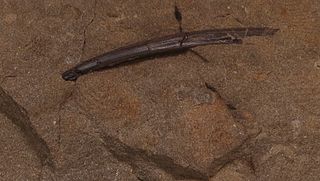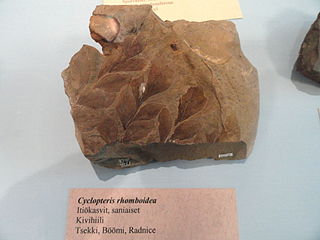Zambiasaurus is an extinct genus of dicynodonts that was discovered in the Middle Triassic (Anisian) Ntawere Formation of Zambia, southern Africa. It was a large dicynodont, reconstructed using several fossil fragments, in majority belonging to probably a juvenile Zambiasaurus submersus.

Terebratulidae is a family of brachiopods with a fossil record dating back to the Late Devonian. It is subdivided into 11 subfamilies.

Corixa is a genus of aquatic bugs in the family Corixidae. The fossil species C. elegans is from the Rott Formation in Nordrhein-Westfalen.
Icriodus is an extinct conodont genus in the family Gnathodontidae.
Ancyrodella is an extinct genus of conodonts from the Late Devonian.
Ancyrognathus is an extinct genus of conodonts.
Siphonodella is an extinct genus of conodonts.
Cryptotaxis is an extinct genus of conodonts in the family Cryptotaxidae from the Famennian.
Calamophylliopsis is a genus of extinct stony corals. They lived from the Early Jurassic to Late Oligocene.
Cardiosyne is an extinct genus of beetles from the Triassic of Argentina. It was originally tentatively classified in Elateridae, but in 2020 it was transferred to Coleoptera incertae sedis.
Cypraedia is an extinct genus of gastropods.
Craniops is an extinct genus of brachiopods in the family Craniopsidae with species known from the Ordovocian to the Devonian.
Phragmolites is an extinct genus of molluscs in the family Bucaniidae, paleozoic molluscs of uncertain position possibly being either Gastropods or Monoplacophorans in the superfamily Bellerophontoidea.
Douvillinella is an extinct genus of prehistoric brachiopods in the extinct family Douvillinidae. Species are from the Devonian of the Czech Republic and Germany. C. elegans is found only at Arauz Formation, Lezna Member, Palencia Province, North Spain.

Cosmacanthus is an extinct genus of placoderms in the extinct family Groenlandaspididae that lived during the Late Devonian in Ireland, the UK, Russia and North America. It was named by Louis Agassiz in 1845.

Cyclopteris is an extinct genus of seed ferns in the extinct family †Cyclopteridaceae. Species are from the Carboniferous.
Clydagnathus is a genus of conodonts in the family Cavusgnathidae. Species are known from the Carboniferous of India and the Devonian of Morocco.
Palaeophasianus is an extinct genus of flightless Geranoididae birds that lived in North America during the Eocene period. Robert Wilson Shufeldt classified Palaeophasianus as a galliform when he described it in 1913. However it was transferred to Cracidae in 1964 by Pierce Brodkorb, while Joel Cracraft in 1968 placed it in Gruiformes.

Furcaster is an extinct genus of brittle stars. It lived from the Silurian to Devonian periods. Furcaster palaeozoicus is known from the Hunsrück Slate lagerstätte.

Hungerfordia is a genus of presumed marine algae first described by Fry and Banks in 1955 in describing Hungerfordia dichotoma from Late Devonian strata. It has been interpreted as a probable brown (Phaeophyte) algae though the possibility that it represents a red (Rhodophyte) alga is not excluded - the taxonomic challenge being that modern red and brown algae are differentiated on the basis of colour and cellular structure which are not preserved in the fossil taxa. Douglas and Jell (1985) suggested that Buthotrephis trichotoma and B. divaricata should furthermore be transferred from Buthotrephis to Hungerfordia.






